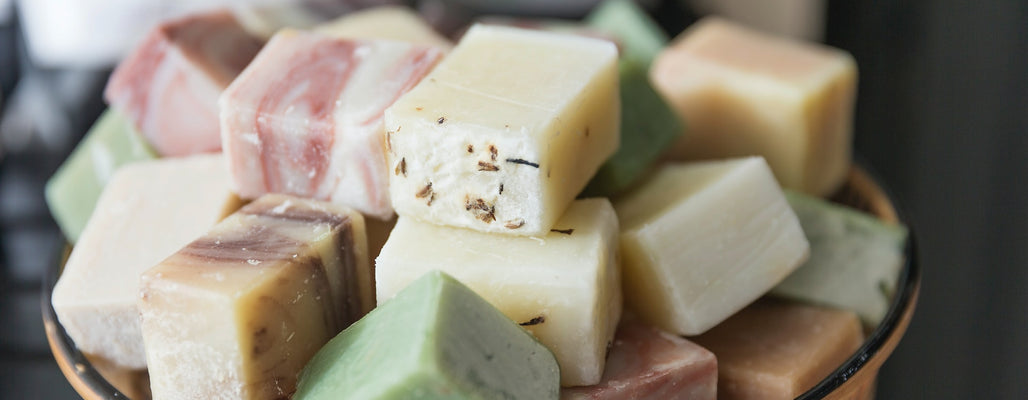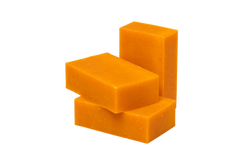
At Botanie, we’ve crafted the perfect soap-making oil blends — unique combinations of organic sunflower, safflower, palm, coconut and castor oils sure to make high-quality bar soap. As a great place to start, pre-blended base oils make the soap-making process more convenient while still allowing you to create your custom soap. In addition to convenience, these blends are tried-and-true and have been proven to create wonderful cleansing bars that are hard and long-lasting, full of moisturizing properties, and produce a dense, creamy lather.
Organic Oil Blends
There are multiple ways to customize the oil blends, including adding additional oils or butters for superfatting, creating your custom essential oil scent blend, and adding specific herbs or botanical ingredients for different colors and exfoliating properties. In this post, I want to specifically address superfatting.
You can use the following table and methods to create custom soap with different superfat levels with our oil blends. The table provides the different levels of water and sodium hydroxide (lye) you should use with your base oils to achieve certain superfat levels. A custom soap containing a good ratio of oils and lye will have between 4%-10% extra oil. The process of superfatting soap ensures that all the lye is reacted out, allowing for a safe bar. This also adds extra oil to the soap, which provides additional moisturizing benefits.

Sodium Hydroxide, Water, and Base Oil Combination Table For Certain Superfat Levels.
There are two ways to go about the superfat process. One, you can simply use the numbers in the table to achieve a certain superfat level for a predetermined amount of oil. In the example below, the combination of water and lye used with 14 pounds of base oils results in a 5% superfat level batch of soap, meaning that 5% of the base oils do not get saponified (turned into soap), but instead remain unchanged and continue to keep their specific beneficial moisturizing properties. For quantities of oil above 5 pounds, such as a 35 pound oil blend, simply take the 5 pound oil row and multiply the lye and water ounces by 7 to get your needed lye and water ounce values.

Combination of Botanie Soap’s 14 pound oil blend, 32 ounces (by weight) of lye, and 84 ounces (by weight) of water to create a final bar of soap with a 5% superfat level.
The second superfat process involves adding extra oils or butters to the oil blend in order to create a really moisturizing batch of soap. This process adds additional superfat properties on top of the already calculated superfat levels in the table above. For our 14 pound oil blend, we recommend up to an additional 3 ounces of another oil (ex. Jojoba Oil, Olive Oil, Rosehip Seed Oil) or butter (ex. Shea Butter, Cocoa Butter, Mango Butter), which will produce very moisturizing bars. For those that may be working with higher quantities of oil, this works out to .2 ounces of superfat oils per 1 pound of base oils. If you want to make sure your final bars remain a firm but still have some extra moisturizing properties, 1 – 2 ounces of additional oils should do the trick.
Starting with a base oil blend can be very helpful and convenient and allow you to still create your custom soap. We hope that these superfatting examples and table are a useful soap-making resource and help everyone take their custom soap to another level through superfatting. Understanding the process is important — but for a quicker alternative to making superfat calculations, you can also use our sponsored recipe calculator on SoapCalc.net.
How Much Essential Oil Should You Use?
This decision is completely up to you. There are many soapmakers who have their own great recipes which may contain different essential oil quantities from what we recommend. The ultimate goal is to produce a high-quality bar that both you and your customers enjoy. With that said, we do have our recommended essential oil quantities that have been proven to work for us in our soap-making.
Before getting into the specific quantities, I want to first provide a little information on why using too much essential oil can possibly decrease your final bar quality:
- Bar Hardness — Too much essential oil can have an adverse affect on the bar hardness, creating a final bar that can be too soft. Softer bars will have a difficult time drying between each use, shortening the bar’s life and costing everyone more.
- Skin Sensitivity — In general, most people don’t get irritated from essential oils in bar soap, but there are some with sensitive skin who may notice higher essential oil levels. It can be worth keeping in mind that bars that contain higher essential oil levels have the potential to be a little irritating for those customers.
The following table shows the essential oil quantity range in ounces for our 14-pound and 35-pound blends. Also included is the essential oil ounce range per pound of oil:
| Recommended Total Essential Oil Usage (In Ounces) For Oil Blends | |
| Ounce of Essential Oil Per Pound of Oil | 0.25 oz – 0.375 oz |
| 14-Pound Oil Blend Range | 3.50 oz – 5.25 oz |
| 35-Pound Oil Blend Range | 8.75 oz – 13.0 oz |
The first row is useful in finding a good amount of essential oil to use for any size batch of soap. If you are only creating a 5-pound oil batch, simply choose a number between the range and multiply it by five (ex. 0.25 x 5 = 1.25 oz of essential oil). The second and third rows are pre-calculated ranges for our 14 and 35-pound blends, which have been calculated by using the oz/lb ratio calculation previously shown.
Tips for Essential Oil Blending
If you’ve perfected your own proven essential oil blend, great! It is always satisfying to achieve that wonderful scent that everybody loves and compliments you on. For those who might be a little newer to soap-making, here are a few tips we’ve put together to help you create your own lovely essential oil blends:
- Top, Middle, and Base Notes — Oils can be categorized into one of these three scent notes depending on their aromatic characteristics. Top note essential oils are more delicate and develop the fastest, middle notes are well-balanced and create the most developed aroma, while base notes are deep and rich and work well to round out blends.
- Softening the Edges — Some essential oils, when used in certain quantities, can be a bit sharp. A great technique to soften their edges is to blend them with a small quantity of an essential oil, such as patchouli (an earthy scent). In small quantities, the patchouli will soften the edges and round out the bar scent without showing through.
- Blending – When it comes to blending, have fun and let your creativity flow. There are no set rules on what works with what, so don’t limit yourself. Here are a few suggestions though to get you started:
- Woodsy oils typically can fit into most any essential oil blends.
- Floral, spicy, and citrus oils work well together. For example, one of our signature blends, citrus lavender, combines floral lavender essential oil with hints of orange, tangerine, and lemon to create a bright and calming scent.
- Spicy oils can be overpowering, so you may want to hold back a little with them.
- Minty, citrus, herbaceous, and earthy also work well together. Our lemongrass tea blend is a great example of citrus essential oils like bergamot, lime, and lemongrass, complementing herbaceous oils like sage and rosemary.
There are multiple ways to customize the oil blends, including adding additional oils or butters for superfatting, creating your custom essential oil scent blend, and adding specific herbs or botanical ingredients for different colors and exfoliating properties. In this post, we are going to specifically address soap scenting.
How can I incorporate herbs or other botanical ingredients into the soap blends?

There are a few ways you can add herbs and/or other botanical ingredients into your soap. Doing so will help you create certain colors and exfoliating characteristics.
- Adding Herbs Directly (No Steeping) — Many colors can be achieved by adding herbs, in powder form, into your soap. Both barley and wheat grass powder are great for getting different shades of green, while annatto seed powder and madder root powder can get you brighter colors. Experimentation is the key. Simply add your desired quantity of powder at trace and mix it in, and you will start to see your color.
- Steeping Herbs in Oil – For certain color ranges it can be beneficial to use the steeping method. Doing so can help achieve more vibrant and consistent colors. Herbs such as annatto seed, alkanet root, and madder root powder work well for this method. If you aren’t familiar with steeping herbs, use the following steps for reference.
- Set aside a small portion of your base oil blend and heat the oils to 110-120 °F.
- Add your herbs to the oil and let steep at that temperature for at least an hour (stir occasionally).
- After about an hour, let the powder settle to the bottom and pour off the colored oil (do your best to keep the powder out of the colored oil).
- Pour your colored oil back into your base oil blend. The quantity of colored oil will usually be less than what you originally started with for steeping. When you mix it back in, it may be necessary to weigh your total base oils again to make sure you have the correct quantity. If you find that you have less than needed, add some extra base oil to top it off. Once you have your colored oil and correct base oil quantity, you can begin your usual soap-making process.
- Adding Herbs for Visual Effect – You can also add herbs that aren’t going to color your soap, but instead create visual properties. Both calendula petals and peppermint leaf are great herbs for creating these visual characteristics. Again, just add these herbs at trace and mix them in.
- Adding Exfoliating Ingredients – Exfoliants are a great way to create bars that have either smooth or rough scrubbing properties. You can use something as fine as pumice to create a subtle scrubbing bar or something as bold as whole oats or large coffee grounds for a tougher scrubbing bar.
The following table shows our recommended quantities for non-steeped herbs, steeped herbs, visual herbs, and exfoliants. We’ve provided quantity ranges per pound to allow you to calculate quantities for different size batch. We also provided the quantity ranges for both our 14 and 35-pound blends. Enjoy experimenting with your soap colors, and feel free to leave us any comments or questions regarding herbs and soap coloring!



